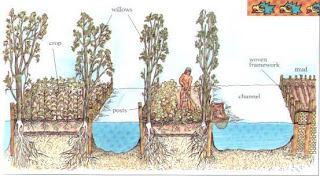In the grand scheme of agriculture and organic food production, aquaponics is still relatively young science. Some people aquaponics debate began. It is widely believed that the Aztecs formed the first version of aquaponics in 1000 on rafts.
It is said that before they settled in Central America, they were nomads wandering around constantly. They settled around marshes like environments surrounded by hills that were almost impossible to cultivate. To produce food, the Aztecs created large rafts and sent in water covered with soil at the bottom of the lake. They placed their seeds on the rafts that became known as chinampas name. As the plants grew roots grow into the soil and into the lake below the raft. And it was the first sign of what we now call aquaponics.
 |
| Aquaponics history, Aztec people |
Aquaponics course has changed a bit since then. We now implement the fish and a wide variety of aquatic life in the systems and do not require a lake thanks to advances in recirculation systems (RAS) Aquaculture. These advances in RAS were allowed to grow large quantities of fish in a much smaller space. However, this raises the question of wastewater that fish produce. Fortunately, other advances have led to the discovery of the use of fish waste to provide nutrients for aquatic plants. This autonomous system took years to develop and is still under development continues today.
 |
| Aquaponics History, Ancient Egyptians |
Aquaponics research itself began in the 1970s and today it is considered by some as the most prestigious in the world to improve the technology involved and develop new methods of university culture. A university that took a lot of effort and the importance of aquaponics is the University of the Virgin Islands. They worked on the experimental agricultural station for over 25 years and have made great progress in the world of aquaponics. Pictured below is the raft system established at the University of the Virgin Islands, led by Dr. James Rakocy.
No comments:
Post a Comment